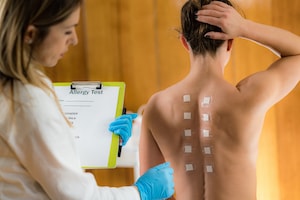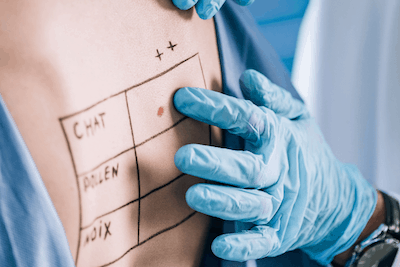How Much Does an Allergy Test Cost?
For those who suffer every spring and fall with red, itchy, watering eyes, and a runny, sneezing, or itchy nose, allergy testing can be a crucial step to receiving proper treatment. Allergists use a variety of tests to determine an appropriate guide to treatment.
How much does it cost to see an allergist? The cost to see an allergist for allergy testing is typically covered by health insurance and is based on the number of allergens involved.
A skin test, for example, is much less expensive than a blood test for the same allergen. If you’re concerned about what is and what isn’t covered by insurance, we recommend asking your insurance carrier these things:
- Is a referral required to see an allergist?
- Is the allergy test you need is covered?
- What is your cost-sharing responsibility under the terms of your plan?
More than 50 million people in the U.S. are allergic to something according to the Centers for Disease Control and Prevention which makes allergies the sixth leading cause of chronic illness in the country.
If you’re covered by health insurance, allergy testing is usually covered. Typical out-of-pocket costs involve a copay for the doctor’s visit. For patients not covered by health insurance, a consultation with an allergist will cost $150 to $300. Depending upon which test you get, you’ll pay an additional $60 to $300 for a skin prick test or $200 to $1,000 for a blood test. Some doctors may offer a discount for patients not using insurance who self-pay. If you believe allergy test is covered by your policy but the insurance company refuses to pay for the treatment, you may need to contact a Lawyer.
Shopping for Allergy Testing
You must select a board-certified allergist to conduct the allergy test because testing results can be affected by the skill level of the practitioner. Board-certified allergists have completed a three-year residency in internal medicine or pediatrics, followed by two to three years of study in allergy and immunology.
When Do You Need an Allergy Test?
 An allergy happens when your immune system overacts to a typically harmless substance–or allergen– that you touch, breathe, or eat. If you wake up to unexplained rashes, a constant runny nose, itchy eyes, or an itchy throat after you eat nuts or a fruit salad, then allergy testing may be the right move for you.
An allergy happens when your immune system overacts to a typically harmless substance–or allergen– that you touch, breathe, or eat. If you wake up to unexplained rashes, a constant runny nose, itchy eyes, or an itchy throat after you eat nuts or a fruit salad, then allergy testing may be the right move for you.
Allergy testing can identify sensitivity to different types of allergens including food, medication, cosmetics, chemicals, and environmental irritants such as dust, mold, grass, animals, and venom. It’s performed on children and adults, and some infants to test for peanut and egg allergies.
Pregnant women are a population for whom allergy testing isn’t recommended due to the risk of having a severe allergic reaction during the testing process. If you are pregnant with a concerning allergy, we recommend you consult an allergist.
When You Don’t Need an Allergy Test
An allergy test isn’t considered preventative care, therefore universal allergy screenings aren’t recommended for patients without symptoms.
Types of Allergy Tests
There are two main types of allergy tests: skin testing and blood testing. Each test may not be appropriate for every individual but under the right circumstances, either one can be a good tool for diagnosing allergies and their specific triggers.
Skin prick tests.
Skin prick tests take about 15 minutes to administer and are widely used to help diagnose allergic conditions, including:
- Hay fever
- Allergic asthma
- Eczema (Dermatitis)
- Food allergies
- Penicillin allergy
- Bee venom allergy
If you can tolerate a skin prick test, it’s usually quick and the results can be determined visually within a few minutes as the skin reacts. They are generally safe, but your doctor may advise against skin testing if you:
- Take medications like antihistamines, antidepressants, and some heartburn medications, that could interfere with test results.
- Have ever had a severe allergic reaction.
- Have certain skin conditions such as psoriasis, eczema, or dermatographism.
A skin prick test involves a series of tiny injections on the surface of the skin or directly into the system. The number of allergens included in the test depends on a patient’s age and symptoms. For babies four to six months old, it’s typically three to five allergens; up to 18 allergens for preschoolers, and up to 50 for teens and adults. This type of test exposes the patient to possible allergens. Because of this, it can be dangerous for those who may have severe allergic reactions.
Patch Tests
 Patch tests don’t use needles. Instead, allergens are applied to patches to see whether a particular substance is causing allergic skin inflammation. A patch test is used for delayed food allergies, or allergic contact dermatitis, where symptoms don’t appear until at least a day after exposure to an allergen. Common patch test allergens include fragrance, ingredients in cosmetics, metals, and preservatives, and chemicals.
Patch tests don’t use needles. Instead, allergens are applied to patches to see whether a particular substance is causing allergic skin inflammation. A patch test is used for delayed food allergies, or allergic contact dermatitis, where symptoms don’t appear until at least a day after exposure to an allergen. Common patch test allergens include fragrance, ingredients in cosmetics, metals, and preservatives, and chemicals.
In a patch test, patches of allergens are applied to a patient’s back in a grid pattern for 48 hours. During this time, full-body showers and sweat-inducing activities are to be avoided. The patches are worn for two days, then removed. Your allergist will check for reactivity the next day or up to three days after the initial application.
Blood Tests
A blood test tends to be more expensive and costs from $200 to $1,000, again depending on how many specific triggers are being isolated. This type of test is safer for individuals who take medications so if you have a condition that requires you to take medicine, you’ll want to consider going this route.
Preparing for an Allergy Test
While the cost and process of being tested can seem daunting, it’s always good to determine exactly what you’re dealing with so you can properly treat it. By guessing how to treat your symptoms, you can spend a lot more money than the one-time cost of an allergy test. It’s well worth the investment to get tested so you can start to treat your allergies.
To come up with a treatment plan, you need to determine what you’re allergic to. A treatment plan means managing and treating the symptoms rather than the cause. Many medications can inhibit the release of histamine and other allergy-inducing chemicals. These medications help alleviate symptoms like redness, itching, swelling, and difficulty breathing.
To prepare for an allergy test, you’ll likely be asked to stop taking allergy medications such as antihistamines a week before your test. If you’re on other medications, like herbal supplements or antidepressants, you may be asked to discontinue them as well.
Before a doctor will conduct an allergy test, he or she will go over your medical history, review your allergy symptoms, and perform a physical exam. This exam may or may not involve an imaging test to look at your lungs or sinuses. You’ll also be asked about your lifestyle, your work environment, and whether you live with pets.
What If You Test Positive in an Allergy Test?
 Before you leave your doctor’s office, you’ll know the results of a skin prick test or an intradermal test. A patch test may take several days or more to produce results.
Before you leave your doctor’s office, you’ll know the results of a skin prick test or an intradermal test. A patch test may take several days or more to produce results.
If you test positive after an allergy test, you and your allergist can talk about your options for treatment. This may include taking over-the-counter medicine or prescription allergy medication. Immunotherapy may also be administered as allergy shots, drops, or tablets. The goal of this approach is to retrain your immune system to tolerate allergen exposure.
You may not need drugs at all; he or she may recommend you steer clear of whatever is causing the allergy, that you make changes to your work or home environment, or dietary changes. Your doctor should have resources to make it easier to avoid triggers. For example, avoidance is a method of managing many food allergies and contact allergies. Patients with allergies to fragrances should receive a list of safe, fragrance-free products.
Test results identify your allergens and a treatment plan to help you take control. With this in place, you’ll be able to reduce or eliminate allergy signs and symptoms. The allergist may recommend additional testing or treatment including prioritizing good nutrition, seeing a dermatologist or even visiting the chiropractor for adjustments. Whatever the approach your allergist recommends, you’ll want to make sure it’s a plan that works for you and your lifestyle.

